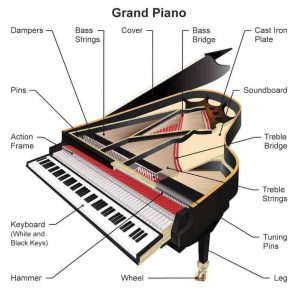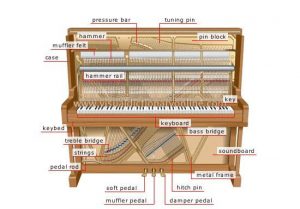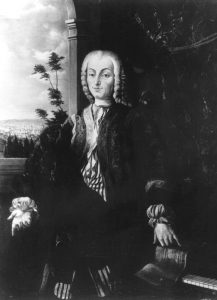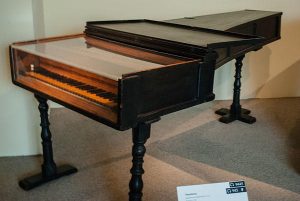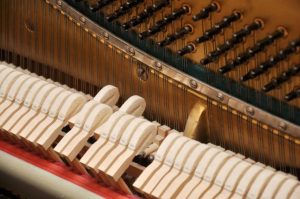The piano is an ingenious invention and, since its creation, its impact on music has probably been greater than any single instrument. The invention of the piano was, indeed, a total game-changer in western music.
How do we categorize the piano?
The acoustic piano is both a percussion and a string instrument. If we want to get technical, some pianos may also be considered an electronic instrument since digital pianos are now very popular, especially among students.
Digital pianos use sound sampling technology to simulate the tone and timbre of an acoustic piano. Sampling is a complex process that employs recordings of an analog sound. In this case, the individual keys (small black and white levers) of the piano are sampled to create a digital or binary waveform. Digital pianos are quite impressive. However, nothing beats an expertly crafted acoustic piano, and we will focus on acoustic pianos in this blog.
What is an acoustic piano?
There are two types of pianos:
1.) The Horizontal (usually called a grand)
There are six sizes of grand pianos on the market today. From smallest to largest, they are:
- Petit grand
- Baby grand
- Medium grand
- Parlor grand
- Semi-concert grand
- Concert grand
The concert grand is truly a grand instrument reaching up to 9 feet long!
2.) The Vertical (usually called an upright)
Vertical pianos also have different sizes. From smallest to largest they are:
- Spinet
- Console
- Studio
- Full upright
The larger the piano, the more robust and rich the tone and resonance becomes.
Let’s Take a Closer Look at How a Piano Works
There are several moving parts on a piano. The most significant of these are the felt hammers attached to the hammer shanks (round wooden dowels). The most prominent feature of the piano is the striking action of the hammers. When the performer presses down a piano key, the hammer is engaged, and it raises to strike the strings.
It may seem like an inconsequential detail now, but in 1700, this hammer action was an extraordinary development.
Harpsichords and clavichords, the leading keyboard instruments of the baroque era, could not play with dynamics. (Dynamics refers to the loudness or softness of a sound.) However, the piano could play a whole range of dynamics!
The first pianos were called the pianoforte. Sometimes the two words were inverted so that the name becomes fortepiano. This inverted name is typically used to refer instruments made in Austria during the 18th century. Either way, all pianos can be played loud and soft (and many dynamics in between). This dynamic range gives composers and performers the ability to create music with much greater musical expression.
Some composers, like J.S. Bach, were slow to embrace the piano but, over time, even the most doubtful musicians became enchanted by it. By the classical era (1730-1820), composers such as Franz Joseph Haydn, Wolfgang Amadeus Mozart, Ludwig Van Beethoven, Muzio Clementi, and many others wrote extensively for the instrument. Throughout the romantic era (1800-1910), the 20th century, and beyond, the piano has remained in the spotlight. Often, musicians will say the piano is “the orchestra at your fingertips.”
How was the piano developed?
The inventor of the piano was Bartolomeo Cristofori (1655-1731). He was an instrument maker from Padua, Italy. Before his work on the piano, he had invented two variations of the harpsichord called the spinnettone and oval spinet, respectively.
Bartolomeo Cristofori di Francesco, inventor of the piano (1655-1731)
Various design changes occurred on the piano during the 1700s and early 1800s, including further development of the hammers, frame, soundboard, pedals, and strings. Sometimes, these innovations were regressions rather than improvements. But eventually, the modern grand piano was born, and the much larger frame (including a heavy cast iron plate) became the standard design for the piano.
Cristofori pianoforte c. 1720
Companies such as Chickering & Sons were popular in the early 1800s. However, Steinway & Sons, founded in 1853, eventually produced the most sought after pianos by professionals and music directors alike. Many other brands of pianos exist too. Yamaha makes excellent pianos, and several boutique companies also arose in the 20th century. One of these is Fazioli, which has been making amazing pianos since 1978.
In addition to the hammer and the strings, the most critical feature of the piano is the soundboard.
When the strings are struck by the hammers, and they vibrate inside the case, the tone is amplified by the soundboard. Soundboards are thin, delicate wooden plates, and they are usually made of spruce. The soundboard – or sound diaphragm – is largely responsible for creating the beautiful sonority of the piano.
Hammers with felt tips on a modern piano
The modern piano contains two rows of 88 black and white keys. The lowest note is called A0 and the highest note is called C8. The 52 white keys of the instrument make up the seven notes of the C major scale (C, D, E, F, G, A, and B). In addition to the white keys, the piano contains 36 shorter black keys, which are located above the white keys, and set further back on the key bed. All totaled, the piano contains 8 full octaves, plus some extra keys on the bottom end. Piano music uses the bass clef to notate pitches in the low to middle ranges, and the treble clef to notate pitches in the middle to high ranges. It’s clear that the piano is here to stay and its influence on musical development since 1700 is truly indispensable.
Photo and Illustration Captions:
Bartolomeo Cristofori di Francesco, inventor of the piano (1655-1731) Cristofori pianoforte c. 1720
Hammers with felt tips on a modern piano
Modern grand (horizontal) piano
Modern upright (vertical) piano
Extensive Range of the piano
Eric Starr

